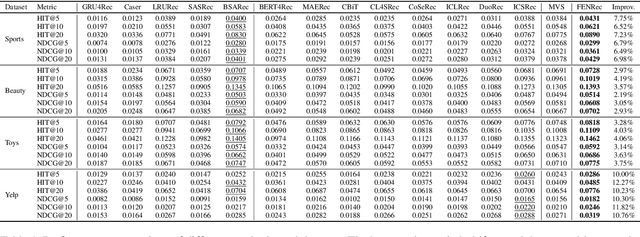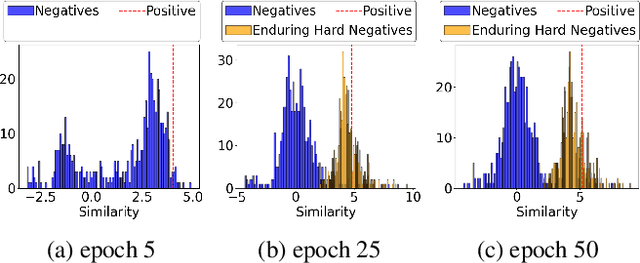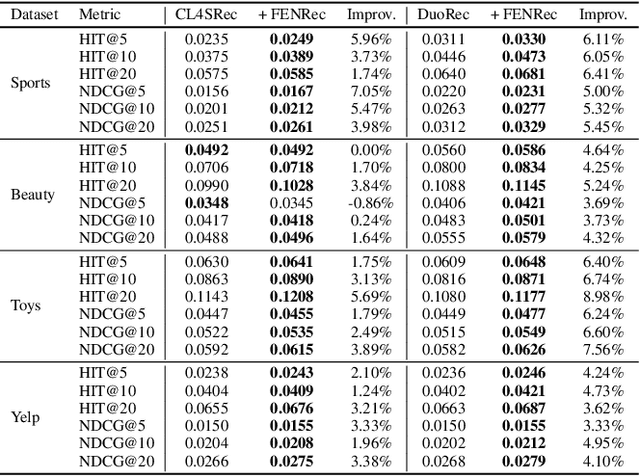Hong-Han Shuai
National Chiao Tung University, Taiwan
Not All Thats Rare Is Lost: Causal Paths to Rare Concept Synthesis
May 27, 2025Abstract:Diffusion models have shown strong capabilities in high-fidelity image generation but often falter when synthesizing rare concepts, i.e., prompts that are infrequently observed in the training distribution. In this paper, we introduce RAP, a principled framework that treats rare concept generation as navigating a latent causal path: a progressive, model-aligned trajectory through the generative space from frequent concepts to rare targets. Rather than relying on heuristic prompt alternation, we theoretically justify that rare prompt guidance can be approximated by semantically related frequent prompts. We then formulate prompt switching as a dynamic process based on score similarity, enabling adaptive stage transitions. Furthermore, we reinterpret prompt alternation as a second-order denoising mechanism, promoting smooth semantic progression and coherent visual synthesis. Through this causal lens, we align input scheduling with the model's internal generative dynamics. Experiments across diverse diffusion backbones demonstrate that RAP consistently enhances rare concept generation, outperforming strong baselines in both automated evaluations and human studies.
Swapped Logit Distillation via Bi-level Teacher Alignment
Apr 27, 2025Abstract:Knowledge distillation (KD) compresses the network capacity by transferring knowledge from a large (teacher) network to a smaller one (student). It has been mainstream that the teacher directly transfers knowledge to the student with its original distribution, which can possibly lead to incorrect predictions. In this article, we propose a logit-based distillation via swapped logit processing, namely Swapped Logit Distillation (SLD). SLD is proposed under two assumptions: (1) the wrong prediction occurs when the prediction label confidence is not the maximum; (2) the "natural" limit of probability remains uncertain as the best value addition to the target cannot be determined. To address these issues, we propose a swapped logit processing scheme. Through this approach, we find that the swap method can be effectively extended to teacher and student outputs, transforming into two teachers. We further introduce loss scheduling to boost the performance of two teachers' alignment. Extensive experiments on image classification tasks demonstrate that SLD consistently performs best among previous state-of-the-art methods.
Single Document Image Highlight Removal via A Large-Scale Real-World Dataset and A Location-Aware Network
Apr 19, 2025Abstract:Reflective documents often suffer from specular highlights under ambient lighting, severely hindering text readability and degrading overall visual quality. Although recent deep learning methods show promise in highlight removal, they remain suboptimal for document images, primarily due to the lack of dedicated datasets and tailored architectural designs. To tackle these challenges, we present DocHR14K, a large-scale real-world dataset comprising 14,902 high-resolution image pairs across six document categories and various lighting conditions. To the best of our knowledge, this is the first high-resolution dataset for document highlight removal that captures a wide range of real-world lighting conditions. Additionally, motivated by the observation that the residual map between highlighted and clean images naturally reveals the spatial structure of highlight regions, we propose a simple yet effective Highlight Location Prior (HLP) to estimate highlight masks without human annotations. Building on this prior, we present the Location-Aware Laplacian Pyramid Highlight Removal Network (L2HRNet), which effectively removes highlights by leveraging estimated priors and incorporates diffusion module to restore details. Extensive experiments demonstrate that DocHR14K improves highlight removal under diverse lighting conditions. Our L2HRNet achieves state-of-the-art performance across three benchmark datasets, including a 5.01\% increase in PSNR and a 13.17\% reduction in RMSE on DocHR14K.
MAD: Makeup All-in-One with Cross-Domain Diffusion Model
Apr 03, 2025



Abstract:Existing makeup techniques often require designing multiple models to handle different inputs and align features across domains for different makeup tasks, e.g., beauty filter, makeup transfer, and makeup removal, leading to increased complexity. Another limitation is the absence of text-guided makeup try-on, which is more user-friendly without needing reference images. In this study, we make the first attempt to use a single model for various makeup tasks. Specifically, we formulate different makeup tasks as cross-domain translations and leverage a cross-domain diffusion model to accomplish all tasks. Unlike existing methods that rely on separate encoder-decoder configurations or cycle-based mechanisms, we propose using different domain embeddings to facilitate domain control. This allows for seamless domain switching by merely changing embeddings with a single model, thereby reducing the reliance on additional modules for different tasks. Moreover, to support precise text-to-makeup applications, we introduce the MT-Text dataset by extending the MT dataset with textual annotations, advancing the practicality of makeup technologies.
Foreground Focus: Enhancing Coherence and Fidelity in Camouflaged Image Generation
Apr 02, 2025Abstract:Camouflaged image generation is emerging as a solution to data scarcity in camouflaged vision perception, offering a cost-effective alternative to data collection and labeling. Recently, the state-of-the-art approach successfully generates camouflaged images using only foreground objects. However, it faces two critical weaknesses: 1) the background knowledge does not integrate effectively with foreground features, resulting in a lack of foreground-background coherence (e.g., color discrepancy); 2) the generation process does not prioritize the fidelity of foreground objects, which leads to distortion, particularly for small objects. To address these issues, we propose a Foreground-Aware Camouflaged Image Generation (FACIG) model. Specifically, we introduce a Foreground-Aware Feature Integration Module (FAFIM) to strengthen the integration between foreground features and background knowledge. In addition, a Foreground-Aware Denoising Loss is designed to enhance foreground reconstruction supervision. Experiments on various datasets show our method outperforms previous methods in overall camouflaged image quality and foreground fidelity.
Anomaly Detection for Hybrid Butterfly Subspecies via Probability Filtering
Apr 02, 2025Abstract:Detecting butterfly hybrids requires knowledge of the parent subspecies, and the process can be tedious when encountering a new subspecies. This study focuses on a specific scenario where a model trained to recognize hybrid species A can generalize to species B when B biologically mimics A. Since species A and B share similar patterns, we leverage BioCLIP as our feature extractor to capture features based on their taxonomy. Consequently, the algorithm designed for species A can be transferred to B, as their hybrid and non-hybrid patterns exhibit similar relationships. To determine whether a butterfly is a hybrid, we adopt proposed probability filtering and color jittering to augment and simulate the mimicry. With these approaches, we achieve second place in the official development phase. Our code is publicly available at https://github.com/Justin900429/NSF-HDR-Challenge.
TF-TI2I: Training-Free Text-and-Image-to-Image Generation via Multi-Modal Implicit-Context Learning in Text-to-Image Models
Mar 19, 2025Abstract:Text-and-Image-To-Image (TI2I), an extension of Text-To-Image (T2I), integrates image inputs with textual instructions to enhance image generation. Existing methods often partially utilize image inputs, focusing on specific elements like objects or styles, or they experience a decline in generation quality with complex, multi-image instructions. To overcome these challenges, we introduce Training-Free Text-and-Image-to-Image (TF-TI2I), which adapts cutting-edge T2I models such as SD3 without the need for additional training. Our method capitalizes on the MM-DiT architecture, in which we point out that textual tokens can implicitly learn visual information from vision tokens. We enhance this interaction by extracting a condensed visual representation from reference images, facilitating selective information sharing through Reference Contextual Masking -- this technique confines the usage of contextual tokens to instruction-relevant visual information. Additionally, our Winner-Takes-All module mitigates distribution shifts by prioritizing the most pertinent references for each vision token. Addressing the gap in TI2I evaluation, we also introduce the FG-TI2I Bench, a comprehensive benchmark tailored for TI2I and compatible with existing T2I methods. Our approach shows robust performance across various benchmarks, confirming its effectiveness in handling complex image-generation tasks.
RecipeGen: A Benchmark for Real-World Recipe Image Generation
Mar 07, 2025



Abstract:Recipe image generation is an important challenge in food computing, with applications from culinary education to interactive recipe platforms. However, there is currently no real-world dataset that comprehensively connects recipe goals, sequential steps, and corresponding images. To address this, we introduce RecipeGen, the first real-world goal-step-image benchmark for recipe generation, featuring diverse ingredients, varied recipe steps, multiple cooking styles, and a broad collection of food categories. Data is in https://github.com/zhangdaxia22/RecipeGen.
Feature-based One-For-All: A Universal Framework for Heterogeneous Knowledge Distillation
Jan 15, 2025Abstract:Knowledge distillation (KD) involves transferring knowledge from a pre-trained heavy teacher model to a lighter student model, thereby reducing the inference cost while maintaining comparable effectiveness. Prior KD techniques typically assume homogeneity between the teacher and student models. However, as technology advances, a wide variety of architectures have emerged, ranging from initial Convolutional Neural Networks (CNNs) to Vision Transformers (ViTs), and Multi-Level Perceptrons (MLPs). Consequently, developing a universal KD framework compatible with any architecture has become an important research topic. In this paper, we introduce a feature-based one-for-all (FOFA) KD framework to enable feature distillation across diverse architecture. Our framework comprises two key components. First, we design prompt tuning blocks that incorporate student feedback, allowing teacher features to adapt to the student model's learning process. Second, we propose region-aware attention to mitigate the view mismatch problem between heterogeneous architecture. By leveraging these two modules, effective distillation of intermediate features can be achieved across heterogeneous architectures. Extensive experiments on CIFAR, ImageNet, and COCO demonstrate the superiority of the proposed method.
Future Sight and Tough Fights: Revolutionizing Sequential Recommendation with FENRec
Dec 16, 2024



Abstract:Sequential recommendation (SR) systems predict user preferences by analyzing time-ordered interaction sequences. A common challenge for SR is data sparsity, as users typically interact with only a limited number of items. While contrastive learning has been employed in previous approaches to address the challenges, these methods often adopt binary labels, missing finer patterns and overlooking detailed information in subsequent behaviors of users. Additionally, they rely on random sampling to select negatives in contrastive learning, which may not yield sufficiently hard negatives during later training stages. In this paper, we propose Future data utilization with Enduring Negatives for contrastive learning in sequential Recommendation (FENRec). Our approach aims to leverage future data with time-dependent soft labels and generate enduring hard negatives from existing data, thereby enhancing the effectiveness in tackling data sparsity. Experiment results demonstrate our state-of-the-art performance across four benchmark datasets, with an average improvement of 6.16\% across all metrics.
 Add to Chrome
Add to Chrome Add to Firefox
Add to Firefox Add to Edge
Add to Edge